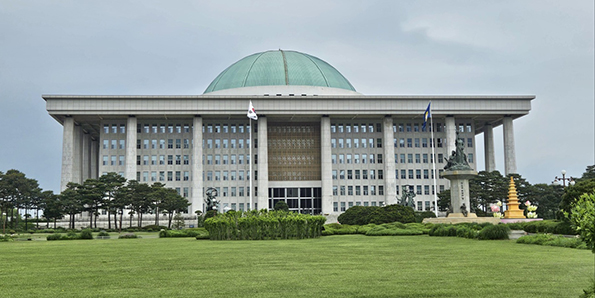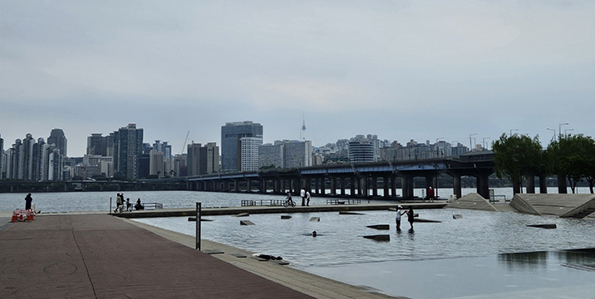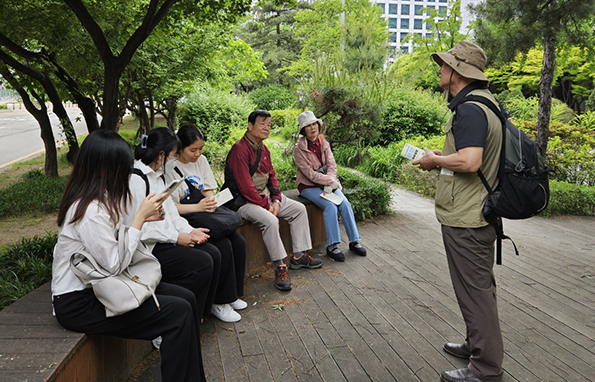
If someone asked which river represented our country, or asked what landmark in Seoul jumps out at them, most people will immediate respond “The Han River!”. This river runs across our country’s central part. It offers citizens places where they can rest and make good memories. The phrase “Miracle on the Han River” is used referring to the economic growth that brought our country to where it is today. Therefore, the river represents our history, culture, and national recreation. The Seoul Metropolitan Government offers a program named “A Tour of Han River’s History” which CBT reporter strongly recommends.
A Tour of Han River’s History is a walking program where participants explore the Han River with a curator. During the tour, they visit nearby cultural heritage sites and engage in discussions about the Han river’s history and culture. The program runs from April 15 to Nov. 30, with two sessions each day (10 a.m. and 2 p.m.). There are a total of 15 courses available, including 8 in Gangnam and 7 in Gangbuk. Additionally, there are 2 night-time courses. The tour is free and requires a minimum of 3 participants. By listening to the curator’s explanations, people can discover lesser-known stories about the Han River and share their thoughts with others of varied ages and professions.
A CBT reporter explored the Yeouinaru route, which is located in Gangnam. This route includes visits to the National Assembly Building, Yeouido Park Cultural Plaza, Traditional Korean Forest, and Yeouido Hangang Park Mulbit Plaza (an artificial water play area). A CBT reporter met with a curator and other participants on the ground floor in front of Exit 6 at the National Assembly Station on Line 9. They walked through the Yeouinaru route together.
National Assembly Building

The building was completed in 1975 and is the largest in the East. It has six stories above ground and two underground levels, supported by 24 octagonal pillars representing the Korea’s 24 solar terms. The dome in the middle of the roof symbolizes parliamentary democracy, where citizens’ opinions come together to make decisions. Interestingly, the National Assembly Building did not always have a dome. However, it’s roof was flat in the old days. After observing foreign buildings, members of the National Assembly recommended constructing a beautiful and authoritative structure. Through this process, the present shape of the National Assembly was achieved. The blue-green dome, unique to the building, radiates unrivaled beauty even from a distance. Additionally, 365 lights adorn the National Assembly Building, symbolizing our hope that lawmakers govern citizens well. The roof, pillars, and lights all reflect care for the people. Visitors can also spot two haetaes’ statues (imaginary animal) near the facade of the National Assembly. These haetaes represent our aspirations for smooth politics and crisis resolution, much like the mythical creatures themselves. The National Assembly building stands as a landmark, embodying both beautiful design and effective government administration in Yeouido.
Yeouido Park Cultural Plaza and Traditional Korean Forest

Yeouido, once known as Yanghwado or Nauiju during the Joseon dynasty, started as a sandy beach. Later, it transformed into a farm where sheep and horse were raised. Since the late 1960s, Yeouido has undergone significant development, resulting in its present form. In 1968, Bamseom Island was exploded, and a polder levee was constructed to manage the Han River’s overflow. In 1970, the opening of Mapo Bridge improved Korea's transportation. High-rise apartment buildings were completed shortly after. By the 1970s, the National Assembly building, KBS (Korean Broadcasting System) broadcasting station, and Korea Stock Exchange were established in Yeouido, making it a hub for politics, broadcasting, and the economy.
During the Japanese colonial period, the second Gyeongseong airfield was built in Yeouido. It was Korea’s first airfield. Yeouido served as an airfield until the 1960s. Later, the runway previously used by the Air Force was transformed into Yeouido Park Cultural Plaza. As people explore this area, people will notice various memorial stones and signs that hint at its history as an old airfield. The park also features a bronze statue of King Sejong, for paying tribute to his achievements. Additionally, there’s a monument commemorating the creation of Hunminjeongum (the Korean script) and a depiction of its spread. Many other pictures and bronze statues celebrate King Sejong’s contributions. Visitors can also see a picture related to the Tsushima subjugation, where Admiral Lee Jong-mu played an active role. Furthermore, there is an image depicting Jiphyeonjeon Hall Scholars engrossed in book research and system development. The park even includes models of inventions like the Armilla, Clepsydra, rainfall measure, and Hemispherical Sundial. Although people cannot directly witness the historical context and inventions from that period, the meticulously restored models allow us to believe in their authenticity. Traditional Korean Forest is a remarkable place that showcases Korea’s traditional forest and garden. Within its serene landscape, people will find two charming gazebos and three picturesque artificial islands. As you explore this natural haven, visitors will discover the essence of Korea’s distinctive beauty. Unlike artificially adorned spaces, Traditional Korean Forest remains unspoiled, allowing its inherent allure to shine through. It is a testament to the timeless elegance and unique character of Korea’s natural landscapes in Yeouido, an alluvial island on the Han River in Seoul, has a rich history spanning various generations. During the Joseon dynasty, it was known by different names. In the Japanese colonial period, it served as an airfield. Today, Yeouido is a bustling hub for politics, economy, broadcasting, and more. The CBT reporter walked through Yeouido Park Cultural Plaza and Traditional Korean Forest, sensed the indirect process of transformation and learned about the island’s many changes and challenges. Despite its evolution, the reporter felt immense pride in Yeouido and cherish this remarkable place.
Yeouido Hangang Park Mulbit Plaza
Passing by Yeouido Park Cultural Plaza and the Forest of Tradition, people will encounter a tunnel that connects to Yeouido Hangang Park. Within this location, people will find an exhibition dedicated to pilot Ahn Chang-nam. Back on Dec. 10, 1922, Pilot Ahn Chang-nam performed an aerobatic flight over the Yeouido sky, bringing hope and joy to people who were feeling despair. If a CBT reporter could travel back to that time and witness Ahn Chang-nam’s daring flight, it might serve as a glimmer of hope during a challenging period. Yeouido Hangang Park Mulbit Plaza is an artificial water play facility fostered by the Seoul Metropolitan Government. This delightful spot allows water to flow into the Han River, creating beautiful fountains and landscapes. Even on cloudy days, many children enjoy playing in the water here. Families also visit frequently. As visitors gaze across the river, people will see Seoul’s iconic landmarks, such as the 63 Building and Namsan Seoul Tower. Additionally, a bronze statue of The Little Mermaid caught the eye of a CBT reporter. Interestingly, Bamseom, which has used to connect with Yeouido, was partially destroyed due to an explosion during dike construction. However, after subsequent development efforts, it has been restored to its original state. Now, Bamseom serves as a habitat for migratory birds and is designated as a Ramsar wetland area.
Yeouinaru Route offers a fascinating journey where people can walk alongside the Han River and listen to professional curator’s explain its history and transformation. Despite some challenging periods, including the Japanese colonial period, Korea has achieved remarkable economic growth. The Yeouinaru route is often described as a “Miracle on the Han River.” The places along this route hold significant importance in shaping present-day Korea.

Other Courses and Tours of the Han Riverʼs History
- A route of Songpanaru (topic: formation and development of Seoul city)
- A route of Han River 100 years Bridge (topic: Gyeongui Lane Railway and Han River’s modern history)
- A route of Yanghwanaru (topic: the influx of foreign cultures)
- A route of Gongamnaru (topic: tale of Han River and Heo-jun)
Registration Process for the Han River’s History Tour:
To register for the Han River’s history tour, visit the website here and complete the pre-reception process at least 5 days before the program date.
Operational Details:
The detailed schedule may vary based on the number of registered participants, the curator’s availability, and the specific course.
Some paid cultural facilities are not covered in the curator’s explanations during stopovers. If participants wish to explore these facilities internally, they can pay the admission fee after the tour program.
Inquiries:
For any questions, contact the following number: 02-761-2578
By Yu So-won
16slysw@chungbuk.ac.kr


 All
All Experience
Experience






 Yu So-won
Yu So-won











